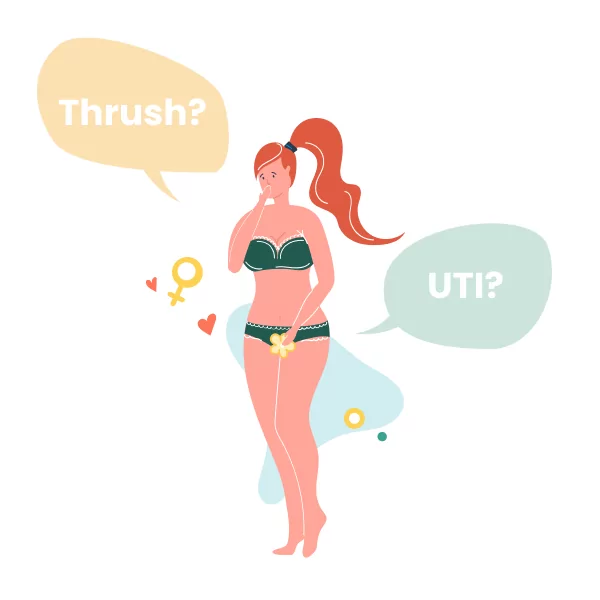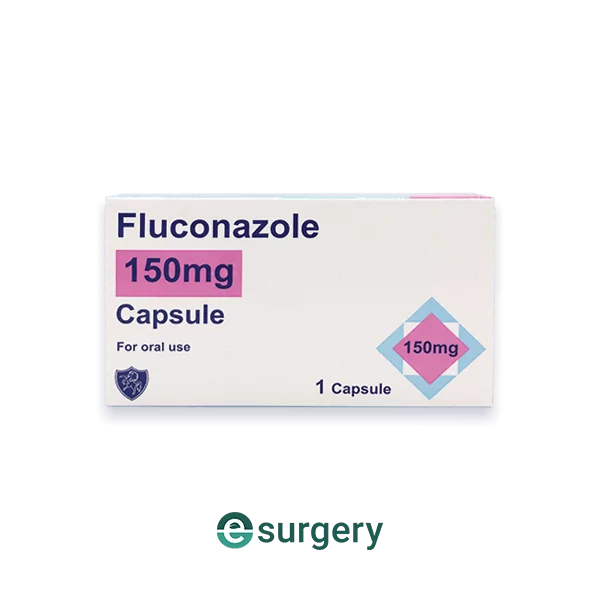
How to tell the difference between thrush or UTI?
If you have vaginal pain accompanied by itching and swelling, you could have a yeast infection known as thrush. However, bacterial infections such as urinary tract infections can cause similar symptoms. So, how to tell the difference between these two conditions?
What is the difference between a UTI and a yeast infection? Is it the same as thrush?
Thrush is a yeast infection, caused by a fungus known as Candida, that builds up on a moist area of your skin, causing itchiness, a thick discharge, and pain when urinating. Whereas a UTI is an infection caused by too many bacteria entering your urinary system.
What are the symptoms of each one and what do they mean? In some cases, the symptoms are so similar that it can be difficult to tell the difference between the two conditions.

What is Thrush?

The vagina contains a delicate balance of bacteria and yeast. If the number of lactobacillus is low, then harmful bacteria called Candida albicans can grow excessively and cause yeast infections such as thrush. The susceptibility towards thrush can be exacerbated by diabetes mellitus [1], immune system disorders such as HIV infection [2], pregnancy, and antibiotics [3].
Thrush is an infection that becomes evident when there is inflammation of the tissues in and around the genitals, including symptoms such as [4]:
- Itching and irritation with redness in and outside of vagina
- Pain during intercourse and urination/defecation
- Vaginal discharge
- Swelling of labia
- Tiredness or fatigue [5]
Vaginal thrush is generally not life-threatening. However, it can become a persistent problem if left untreated or allowed to worsen over time. Thrush treatment category includes an antifungal medication that helps you avoid reaching this stage.
What is a UTI?

UTIs are caused by bacteria, usually Escherichia coli [6], entering the urethra and traveling up into the bladder where it begins multiplying. As the infection progresses through the urinary tract system it can cause a wide range of different symptoms including [4]:
- Pain while urinating/defecating
- Unusual discharge from vagina
- Blood in urine, pain with urination
- A frequent urge to urinate
- Lower abdominal pain that may also radiate into the back and groin (UTI pain can sometimes be worse at night)

These symptoms are very uncomfortable and may build up over time. For some women who experience recurrent UTIs, kidney issues might be present and there is the possibility of damage to the kidneys over time [7].
For killing the E. coli bacteria, you can opt for the UTI treatment category which includes an antibiotic course to be taken for 3 days to prevent further infections.
Is thrush a UTI?
No, despite similarities, thrush is not a UTI. Whilst both cause itching and pain when urinating, the infections differ in many ways. Thrush is a yeast infection, caused by a build up of a fungus in a moist area. Whereas a UTI is a bacterial infection, caused by bacteria entering your urinary tract.
How Can I Tell the Difference?
Urinary tract infections (UTIs) and yeast infections (thrush) can both cause itching and discomfort. But there are some important differences between the two that will help you answer the question, ‘Do I have thrush or UTI?’, such as:
- The appearance of your urine can tell quite a bit about what’s going on inside your body. In the case of a UTI, your urine may be cloudy or have a bad odour. It may also appear pink or red if blood is present in the urine. On the other hand, vaginal discharge from thrush will more than likely be odourless and have a texture that looks similar to cottage cheese.
- Thrush typically causes very painful urination without any other symptoms, while a UTI can cause pain during urination as well as nausea/vomiting and lower abdominal pain (in severe cases).
- Unlike thrush, UTI can cause bacteria to get into the bloodstream and result in more serious health issues.
Can I Have Thrush and UTI at the Same Time?
Yes, it is possible to contract thrush or UTI infections at the same time. It is also possible to experience symptoms of both infections such as discharge, irritation, and itching.
Some women experience recurring yeast infections due to the overuse of antibiotics for UTI treatment, which kill both good and bad bacteria in the vagina. This can lead to an imbalanced pH level, which encourages the growth of Candida albicans [4].
In the same way, Candida may cause UTI as well [8]. Though it’s possible to have both at the same time, they’re treated separately for different symptoms.
Can thrush cause STI?
No, thrush cannot cause an STI. Despite the fact both can be transmitted through sexual intercourse, thrush is not a sexually transmitted disease. Thrush is a yeast infection, caused when a fungus called Candida builds up in a moist area, whilst an STI is transmitted through sexual contact or bodily fluids, and can be either a virus, bacteria or parasite.
Is There Medication to Help Thrush and UTI?
Yes, medications are available to help treat both conditions. The major difference between the treatment for both infections is what they are caused by.
The Thrush treatment category targets infections caused by fungi, effectively preventing a candida infection. This medication comes in pill form for oral ingestion. Fluconazole works by killing fungus locally but also all over the body so it lowers your chances of getting future infections. You can buy fluconazole over the counter.

Similarly, the UTI treatment category aims to kill the bacteria causing this medical condition. The antibiotic course contains Trimethoprim tablets that should be taken to prevent a future UTI and not to treat acute cases

If you have a more severe case of thrush or UTI, and experience any side effects, immediately consult your doctor.
Sources
- Candida sp. Infections in Patients with Diabetes Mellitus (NCBI)
- Candida Infections of the Genitourinary Tract (NCBI)
- Vaginal Thrush (NHS)
- What’s the Difference Between a Yeast Infection and a Urinary Tract Infection (UTI)? (Healthline)
- 7 Symptoms of Candida Overgrowth (Plus How to Get Rid of It) (Healthline)
- Why the Most Common Cause of UTIs Is E. Coli (Healthline)
- Chronic Urinary Tract Infection (UTI) (Healthline)
- Urinary tract infections and Candida albicans (NCBI)
Further Reading
- Is it a yeast infection or a urinary tract infection? (Medical News Today)
- Is It a UTI or a Yeast Infection? Here’s How to Tell the Difference (Self)
- The Differences Between a UTI and a Yeast Infection (The Woman’s Clinic)









